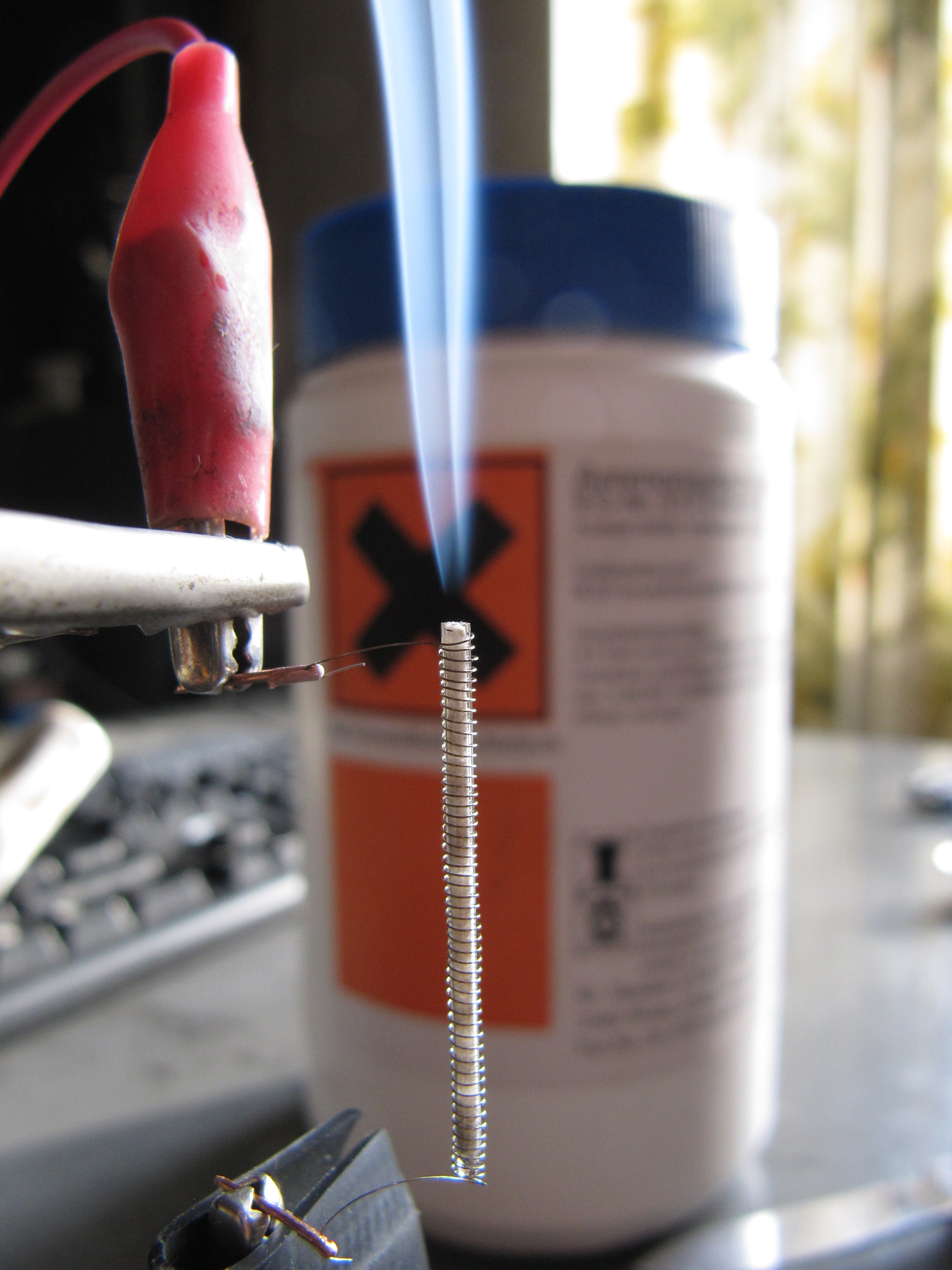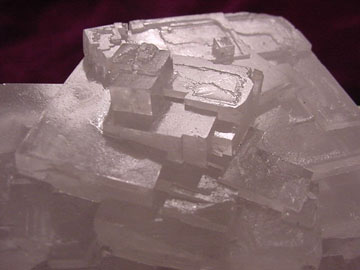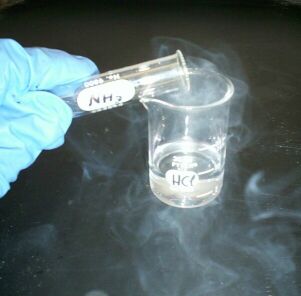|
Salammoniac
Salammoniac, also sal ammoniac or salmiac, is a rare naturally occurring mineral composed of ammonium chloride, NH4Cl. It forms colorless, white, or yellow-brown crystals in the isometric-hexoctahedral class. It has very poor cleavage and is brittle to conchoidal fracture. It is quite soft, with a Mohs hardness of 1.5 to 2, and it has a low specific gravity of 1.5. It is water-soluble. Salammoniac is also the archaic name for the chemical compound ammonium chloride. History Pliny, in Book XXXI of his ''Natural History'', refers to a salt produced in the Roman province of Cyrenaica named ''hammoniacum'', so called because of its proximity to the nearby Temple of Jupiter Amun (Greek Ἄμμων ''Ammon''). However, the description Pliny gives of the salt does not conform to the properties of ammonium chloride. According to Herbert Hoover's commentary in his English translation of Georgius Agricola's '' De re metallica'', it is likely to have been common sea salt. Neverthele ... [...More Info...] [...Related Items...] OR: [Wikipedia] [Google] [Baidu] |
Ammonium Chloride
Ammonium chloride is an inorganic chemical compound with the chemical formula , also written as . It is an ammonium salt of hydrogen chloride. It consists of ammonium cations and chloride anions . It is a white crystalline salt (chemistry), salt that is highly soluble in water. Solutions of ammonium chloride are mildly acidic. In its naturally occurring mineralogic form, it is known as salammoniac. The mineral is commonly formed on burning coal dumps from condensation of coal-derived gases. It is also found around some types of volcanic vents. It is mainly used as fertilizer and a flavouring agent in Salty liquorice, some types of liquorice. It is a product of the reaction of hydrochloric acid and ammonia. Production It is a product of the Solvay process used to produce sodium carbonate: :CO2 + 2 NH3 + 2 NaCl + H2O → 2 NH4Cl + Na2CO3 Not only is that method the principal one for the manufacture of ammonium chloride, but also it is used to minimize ammonia release in some ind ... [...More Info...] [...Related Items...] OR: [Wikipedia] [Google] [Baidu] |
Halide Mineral
Halide minerals are those minerals with a dominant halide anion (, , and ). Complex halide minerals may also have Polyatomic ion, polyatomic anions. Examples include the following: *Atacamite *Avogadrite (K,Cs)BF *Bararite (β) *Bischofite *Brüggenite *Calomel *Carnallite *Carnallite *Cerargyrite/Horn silver AgCl *Chlorargyrite AgCl, bromargyrite AgBr, and iodargyrite AgI *Cryolite *Cryptohalite (a) . *Dietzeite *Eglestonite *Embolite AgCl+AgBr *Eriochalcite *Fluorite *Halite NaCl *Lautarite *Marshite CuI *Miersite AgI *Nantokite CuCl *Sal Ammoniac *Sylvite KCl *Terlinguaite *Tolbachite *Villiaumite NaF *Yttrocerite (Ca,Y,Ce)F2 *Yttrofluorite (Ca,Y)F2 *Zavaritskite (BiO)F Many of these minerals are water-soluble and are often found in ar ... [...More Info...] [...Related Items...] OR: [Wikipedia] [Google] [Baidu] |
Pliny The Elder
Gaius Plinius Secundus (AD 23/24 79), known in English as Pliny the Elder ( ), was a Roman Empire, Roman author, Natural history, naturalist, and naval and army commander of the early Roman Empire, and a friend of the Roman emperor, emperor Vespasian. He wrote the encyclopedic (''Natural History''), a comprehensive thirty-seven-volume work covering a vast array of topics on human knowledge and the natural world, which became an editorial model for encyclopedias. He spent most of his spare time studying, writing, and investigating natural and geographic phenomena in the field. Among Pliny's greatest works was the twenty-volume ''Bella Germaniae'' ("The History of the German Wars"), which is Lost literary work, no longer extant. ''Bella Germaniae'', which began where Aufidius Bassus' ''Libri Belli Germanici'' ("The War with the Germans") left off, was used as a source by other prominent Roman historians, including Plutarch, Tacitus, and Suetonius. Tacitus may have used ''Bella Ger ... [...More Info...] [...Related Items...] OR: [Wikipedia] [Google] [Baidu] |
Volcanic
A volcano is commonly defined as a vent or fissure in the crust of a planetary-mass object, such as Earth, that allows hot lava, volcanic ash, and gases to escape from a magma chamber below the surface. On Earth, volcanoes are most often found where tectonic plates are diverging or converging, and because most of Earth's plate boundaries are underwater, most volcanoes are found underwater. For example, a mid-ocean ridge, such as the Mid-Atlantic Ridge, has volcanoes caused by divergent tectonic plates whereas the Pacific Ring of Fire has volcanoes caused by convergent tectonic plates. Volcanoes resulting from divergent tectonic activity are usually non-explosive whereas those resulting from convergent tectonic activity cause violent eruptions."Mid-ocean ridge tectonics, volcanism and geomorphology." Geology 26, no. 455 (2001): 458. https://macdonald.faculty.geol.ucsb.edu/papers/Macdonald%20Mid-Ocean%20Ridge%20Tectonics.pdf Volcanoes can also form where there is stretching a ... [...More Info...] [...Related Items...] OR: [Wikipedia] [Google] [Baidu] |
Volcanic Sublimate
A volcano is commonly defined as a vent or fissure in the crust of a planetary-mass object, such as Earth, that allows hot lava, volcanic ash, and gases to escape from a magma chamber below the surface. On Earth, volcanoes are most often found where tectonic plates are diverging or converging, and because most of Earth's plate boundaries are underwater, most volcanoes are found underwater. For example, a mid-ocean ridge, such as the Mid-Atlantic Ridge, has volcanoes caused by divergent tectonic plates whereas the Pacific Ring of Fire has volcanoes caused by convergent tectonic plates. Volcanoes resulting from divergent tectonic activity are usually non-explosive whereas those resulting from convergent tectonic activity cause violent eruptions."Mid-ocean ridge tectonics, volcanism and geomorphology." Geology 26, no. 455 (2001): 458. https://macdonald.faculty.geol.ucsb.edu/papers/Macdonald%20Mid-Ocean%20Ridge%20Tectonics.pdf Volcanoes can also form where there is stretching an ... [...More Info...] [...Related Items...] OR: [Wikipedia] [Google] [Baidu] |
Pseudo-Geber
Pseudo-Geber (or "Middle Latin, Latin pseudo-Geber") is the presumed author or group of authors responsible for a corpus of pseudepigraphic alchemical writings dating to the late 13th and early 14th centuries. These writings were falsely attributed to Jabir ibn Hayyan (died 816, Latinisation of names, Latinized as Geber), an early Alchemy, alchemist of the Islamic Golden Age. The most important work of the Latin pseudo-Geber corpus is the ("The Height of the Perfection of Mastery"), which was likely written slightly before 1310. Its actual author has been tentatively identified as Paul of Taranto. The work was influential in the domain of alchemy and metallurgy in late medieval Europe. The work contains experimental demonstrations of the corpuscularianism, corpuscular nature of matter that were still being used by seventeenth-century chemists such as Daniel Sennert, who in turn influenced Robert Boyle. The work is among the first to describe nitric acid, aqua regia, and aqua fo ... [...More Info...] [...Related Items...] OR: [Wikipedia] [Google] [Baidu] |
Ammonium
Ammonium is a modified form of ammonia that has an extra hydrogen atom. It is a positively charged (cationic) polyatomic ion, molecular ion with the chemical formula or . It is formed by the protonation, addition of a proton (a hydrogen nucleus) to ammonia (). Ammonium is also a general name for positively charged (protonated) substituted amines and quaternary ammonium cations (), where one or more hydrogen atoms are replaced by Organic compound, organic or other groups (indicated by R). Not only is ammonium a source of nitrogen and a key metabolite for many living organisms, but it is an integral part of the global nitrogen cycle. As such, human impact in recent years could have an effect on the biological communities that depend on it. Acid–base properties The ammonium ion is generated when ammonia, a weak base, reacts with Brønsted–Lowry acid–base theory, Brønsted acids (proton donors): : The ammonium ion is mildly acidic, reacting with Brønsted bases to return ... [...More Info...] [...Related Items...] OR: [Wikipedia] [Google] [Baidu] |
Ammonia
Ammonia is an inorganic chemical compound of nitrogen and hydrogen with the chemical formula, formula . A Binary compounds of hydrogen, stable binary hydride and the simplest pnictogen hydride, ammonia is a colourless gas with a distinctive pungent smell. It is widely used in fertilizers, refrigerants, explosives, cleaning agents, and is a precursor for numeous chemicals. Biologically, it is a common nitrogenous waste, and it contributes significantly to the nutritional needs of terrestrial organisms by serving as a precursor to fertilisers. Around 70% of ammonia produced industrially is used to make fertilisers in various forms and composition, such as urea and diammonium phosphate. Ammonia in pure form is also applied directly into the soil. Ammonia, either directly or indirectly, is also a building block for the synthesis of many chemicals. In many countries, it is classified as an List of extremely hazardous substances, extremely hazardous substance. Ammonia is toxic, cau ... [...More Info...] [...Related Items...] OR: [Wikipedia] [Google] [Baidu] |
Sea Salt
Sea salt is salt that is produced by the evaporation of seawater. It is used as a seasoning in foods, cooking, cosmetics and for preserving food. It is also called bay salt, solar salt, or simply salt. Like mined rock salt, production of sea salt has been dated to prehistoric times. Composition Commercially available sea salts on the market today vary widely in their chemical composition. Although the principal component is sodium chloride, the remaining portion can range from less than 0.2 to 22% of other salts. These are mostly calcium, potassium, and magnesium salts of chloride and sulfate with substantially lesser amounts of many trace elements found in natural seawater. Though the composition of commercially available salt may vary, the ionic composition of natural saltwater is relatively constant. Historical production Sea salt is mentioned in the Vinaya Pitaka, a Buddhist scripture compiled in the mid-5th century BC. The principle of production is evaporation of the ... [...More Info...] [...Related Items...] OR: [Wikipedia] [Google] [Baidu] |
Georgius Agricola
Georgius Agricola (; born Georg Bauer; 24 March 1494 – 21 November 1555) was a German Humanist scholar, mineralogist and metallurgist. Born in the small town of Glauchau, in the Electorate of Saxony of the Holy Roman Empire, he was broadly educated, but took a particular interest in the mining and refining of metals. He was the first to drop the Arabic definite article ''al-'', exclusively writing ''chymia'' and ''chymista'' in describing activity that we today would characterize as chemical or alchemical, giving chemistry its modern name. For his groundbreaking work '' De Natura Fossilium'' published in 1546, he is generally referred to as the father of mineralogy and the founder of geology as a scientific discipline.Rafferty, John P. (2012). ''Geological Sciences; Geology: Landforms, Minerals, and Rocks''. New York: Britannica Educational Publishing, p. 10. He is well known for his pioneering work '' De re metallica libri XII'', that was published in 1556, one yea ... [...More Info...] [...Related Items...] OR: [Wikipedia] [Google] [Baidu] |
Herbert Hoover
Herbert Clark Hoover (August 10, 1874 – October 20, 1964) was the 31st president of the United States, serving from 1929 to 1933. A wealthy mining engineer before his presidency, Hoover led the wartime Commission for Relief in Belgium and was the director of the U.S. Food Administration, followed by post-war relief of Europe. As a member of the Republican Party (United States), Republican Party, he served as the third United States secretary of commerce from 1921 to 1928 before being 1928 United States presidential election, elected president in 1928. His presidency was dominated by the Great Depression, and his policies and methods to combat it were seen as lackluster. Amid his unpopularity, he decisively lost reelection to Franklin D. Roosevelt in 1932 United States presidential election, 1932. Born to a Quaker family in West Branch, Iowa, Hoover grew up in Oregon. He was one of the first graduates of the new Stanford University in 1895. Hoover took a position with a Lond ... [...More Info...] [...Related Items...] OR: [Wikipedia] [Google] [Baidu] |









